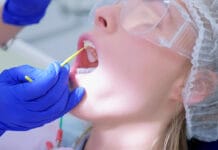Dental hygienists provide care to patients in varying life stages, often tailoring recommendations based on a patient’s current stage of life. It is essential to ensure that personalized care and advice are given to each patient. A dental hygienist may often provide care for a pregnant mother or newly postpartum mother, each of which will require unique care to their needs during this stage of life.
One of the most common inquiries from such patients is regarding breastfeeding. It can be a delicate topic, and this should be considered. However, if the patient confides in their dental hygienist (as they often do), it is important to better understand some of the benefits of breastfeeding an infant.
Health Benefits to Mother and Child
Breastfeeding can provide countless benefits for a baby’s overall health. The Centers for Disease Control and Prevention (CDC) reports that breastfeeding babies will reduce the risk of many preventable diseases. The CDC states, “Infants who are breastfed have reduced risks of asthma, obesity, type 1 diabetes, severe lower respiratory disease, acute otitis media (ear infections), sudden infant death syndrome (SIDS), and gastrointestinal infections (diarrhea/vomiting).”2
Breastfeeding can provide an infant with many nutrients that support infant growth and development.
There are also benefits to the breastfeeding mother as well. The American Academy of Pediatrics (AAP) notes, “Mothers who breastfeed their babies have a lower risk of breast cancer, ovarian cancer, type 2 diabetes, and high blood pressure.” 1
The postpartum period is a joyous time but also is a major adjustment period. It’s been shown that breastfeeding can provide some emotional benefits as well. According to the AAP, mothers who breastfeed recover from childbirth more easily and quickly. This is due to the hormone oxytocin, which is released during breastfeeding. It acts to return the uterus to its regular size more quickly and can reduce postpartum bleeding.1
As a healthcare provider, it is important to understand the overall health benefits of breastfeeding and its potential to protect both mother and baby from short and long-term illnesses and diseases.
Oral Health Benefits of Breastfeeding
More specific questions are often asked in regards to ways in which breastfeeding can affect an infant’s oral health. Fortunately, there are known oral health benefits to breastfeeding and the way it affects craniofacial growth and development.
Craniofacial development is affected by the way in which an infant may suck, swallow, chew and breathe. The mouth movements associated with breastfeeding differ from that of bottle-feeding. Breastfeeding is summarized as drawing milk, putting both the nipple and areola into the mouth. The movement of lips and tongue contribute more to squeezing than to sucking.
In contrast, the mouth movements in bottle-fed babies are summarized as using the tongue with piston-like motion in order to compress the artificial teat against the palate. The difference in sucking mechanisms means a bottle-fed infant is predisposed to the development of malocclusion. As a result, one oral health benefit to breastfeeding is that breastfed children may develop favorable occlusion in primary teeth.3
Another consideration that should be made about breastfeeding is a child’s risk for early childhood caries (ECC). Many studies confirm or deny the correlation between breast milk and early childhood caries, and the results are inconclusive. Due to current evidence proving important maternal and child health benefits associated with breastfeeding, scientifically rigorous research is needed about whether associations exist between breastfeeding and early childhood caries, and such evidence is lacking.3
With patient education being such an important responsibility of the dental hygienist, it is valuable to understand the benefits of breastfeeding and provide encouragement while educating the patient about the best practices to prevent early childhood caries. There are multifactorial causes of early childhood decay that may be linked to sweet foods, feeding during the night, and multiple carbohydrate meals throughout the day. It’s best to educate the patient by encouraging a healthy, nutritious diet and teaching appropriate oral hygiene habits.
“The most recent recommendations of pediatric and dental societies advise breastfeeding until the age of 2 years, suggesting that this be accompanied by toothbrushing and better nutrition by reducing the frequency and consumption of sugary foods, aimed at helping parents choose prolonged breastfeeding.”4
The current recommendation is to ensure the breastfeeding mother understands healthy oral hygiene habits for their baby, especially upon the eruption of their first tooth. Recommendations according to The American Dental Association and The American Academy of Pediatric Dentistry policies that are relevant to breastfeeding have been revised in such a way that encourages clinicians to promote dietary recommendations to their breastfeeding patients. The American Academy of Pediatric Dentistry (AAPD) has no specific policy referencing breastfeeding, but a recently revised policy on the dietary recommendations for infants, children, and adolescents, the association “encourages breastfeeding of infants to ensure the best possible health and developmental and psychosocial outcomes, with care to wiping or brushing as the first primary tooth begins to erupt and other dietary carbohydrates are introduced.” 3
The oral hygiene instructions for an infant are pretty simple but important. It is essential that postpartum mothers get into the habit of cleaning their baby’s mouths at least once per day. This can be done through the use of a dampened soft cloth or gauze to wipe the infants’ gingiva and teeth. The practice of wiping out the babys’ mouth can begin prior to the eruption of their first primary tooth. Upon eruption of the first primary tooth, a soft-bristled brush can be introduced to clean the primary teeth. Once the child’s first tooth appears, it’s time to schedule their first dental visit. The ADA recommends that the first dental appointment takes place within six months after the first tooth appears and no later than a child’s first birthday.
Dental hygienists often provide care to pregnant mothers and postpartum mothers, and it’s important to individualize their recommendations based on the patient’s current needs. In the circumstance of pregnant and postpartum mothers, it may mean providing encouragement and education relevant to the benefits of breastfeeding.
Before you leave, check out the Today’s RDH self-study CE courses. All courses are peer-reviewed and non-sponsored to focus solely on high-quality education. Click here now.
Listen to the Today’s RDH Dental Hygiene Podcast Below:
References
- Benefits of Breastfeeding for Mom. (2016, July 25). American Academy of Pediatrics. Retrieved from https://www.healthychildren.org/english/ages-stages/baby/breastfeeding/pages/benefits-of-breastfeeding-for-mom.aspx
- About breastfeeding. (2020, May 28). Centers for Disease Control and Prevention. Retrieved from https://www.cdc.gov/breastfeeding/about-breastfeeding/index.html
- Salone, L.R., Vann, W.F., Dee, D.L. Breastfeeding. The Journal of the American Dental Association. 2013; 144(2): 143–151. Retrieved from https://doi.org/10.14219/jada.archive.2013.0093
- Branger, B., Camelot, F., Droz, D., Houbiers, B., Marchalot, A., Bruel, H., Laczny, E., & Clement, C. (2019). Breastfeeding and early childhood caries. Review of the literature, recommendations, and prevention. Archives De Pédiatrie, 26(8), 497–503. Retrieved from https://doi.org/10.1016/j.arcped.2019.10.004












